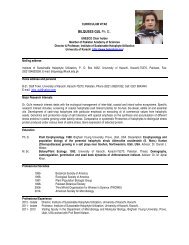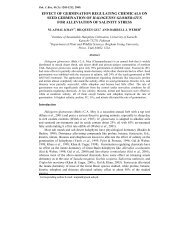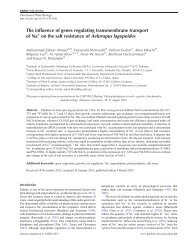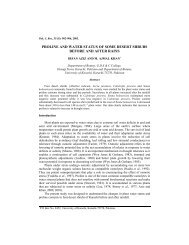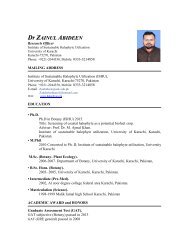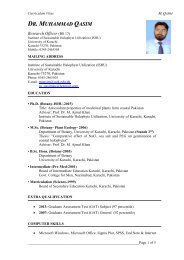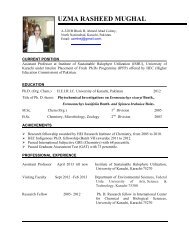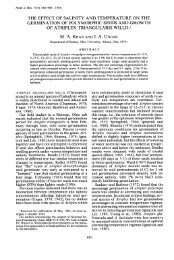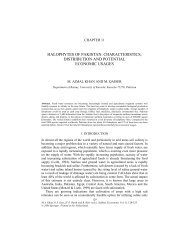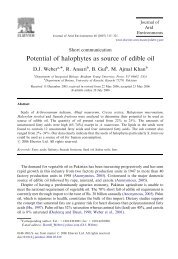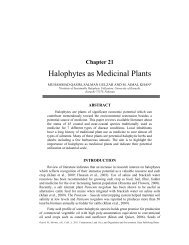Germination strategies of halophyte seeds under ... - ResearchGate
Germination strategies of halophyte seeds under ... - ResearchGate
Germination strategies of halophyte seeds under ... - ResearchGate
You also want an ePaper? Increase the reach of your titles
YUMPU automatically turns print PDFs into web optimized ePapers that Google loves.
G Model<br />
EEB-2616; No. <strong>of</strong> Pages 15<br />
ARTICLE IN PRESS<br />
B. Gul et al. / Environmental and Experimental Botany xxx (2012) xxx–xxx 11<br />
(Ahmed and Khan, 2010), seed germination after halopriming was<br />
similar to total germination in water, indicating osmotic constraint<br />
<strong>under</strong> saline condition. While germination in several other species<br />
like Suaeda salsa (Guan et al., 2010), Salsola iberica (Khan et al.,<br />
2002a) and Haloxylon persicum (Song et al., 2005) is lower than<br />
the germination in water.<br />
5.4. Conclusion<br />
It appears that osmopriming is a phenomenon that is not very<br />
common in species <strong>of</strong> any region. However some species in all habitats<br />
show positive effect <strong>of</strong> halopriming which ranges from almost<br />
none to 200% stimulation while others show significant reduction<br />
in germination when halo-primed.<br />
6. Seed heteromorphism<br />
Seed heteromorphism is a phenomenon in which an individual<br />
plant produces different morpho-physiological types <strong>of</strong> <strong>seeds</strong>,<br />
and it is common in Asteraceae, Chenopodiaceae (now Amaranthaceae)<br />
and Poaceae (Harper, 1977; Imbert, 2002). More than 200<br />
species are reported worldwide to exhibit seed heteromorphism<br />
ranging from difference in colour, size and shape, as well as in dispersal<br />
capacity, germination characteristics, dormancy responses,<br />
ability to persist in a seed bank and seedling growth (Sorensen,<br />
1978; Baker and O’Dowd, 1982; Khan and Ungar, 1984; Cheplick,<br />
1994; Baskin and Baskin, 1998; Mandák and Pyšek, 2005; Imbert,<br />
2002; Brändel, 2004; Lu et al., 2010).<br />
The phenomenon <strong>of</strong> dimorphism or polymorphism most probably<br />
provides multiple opportunities for a population to maintain<br />
its continuity when faced with extreme variation in environmental<br />
conditions <strong>of</strong> saline habitats (Philipupillai and Ungar, 1984; Khan<br />
and Ungar, 1986a). Seed heteromorphism is not frequent but has<br />
been reported among annuals as well as perennials, irrespective <strong>of</strong><br />
region or climatic conditions (Ungar, 1995; Khan and Gul, 2006).<br />
For instance, a number <strong>of</strong> halophytic taxa including Arthrocnemum,<br />
Atriplex, Chenopodium, Cakile, Salicornia, Salsola, Spergularia, Suaeda<br />
and Trianthema (Ungar, 1977; Galinato and van der Valk, 1986;<br />
Mohammad and Sen, 1991; Ungar, 1988; Morgan and Myers, 1989;<br />
Khan and Gul, 1998) show seed heteromorphism.<br />
6.1. Subtropical habitats<br />
Studies conducted in Jodhpur, India reported that seed <strong>of</strong> several<br />
<strong>halophyte</strong>s (Cressa cretica, Salsola imbricata, Sesuvium sesuvioides,<br />
Suaeda fruticosa, Trianthema triquetra and Zygophyllum simplex)<br />
were heteromorphic (Mohammad and Sen, 1991). These variations<br />
in seed size and weight may be an adaptive response to a<br />
large variation in soil salinity at different habitats. Seed dimorphism<br />
is reported in a stem succulent <strong>halophyte</strong>, Arthrocnemum<br />
macrostachyum, which is frequently distributed in coastal salt<br />
marshes <strong>of</strong> the Arabian Sea including Pakistan. It produces dimorphic<br />
brown and heavier black <strong>seeds</strong> (Khan and Gul, 1998). Brown<br />
<strong>seeds</strong> germinated at 1 M NaCl while few black <strong>seeds</strong> germinated<br />
at 0.8 M NaCl. Halopyrum mucronatumis a perennial grass which<br />
is the second most common species along the Arabian Sea coast<br />
after Arthrocnemum macrostachyum; it produces <strong>seeds</strong> twice a year.<br />
Summer <strong>seeds</strong> produced during May are black and heavier than<br />
brown <strong>seeds</strong> which are produced during November (Noor and<br />
Khan, 1995). Summer <strong>seeds</strong> were found more tolerant to salinity<br />
than winter <strong>seeds</strong> and showed better germination in a warmer<br />
(20–30 ◦ C) rather than a cooler (10–20 ◦ C) temperature regime<br />
(Khan and Ungar, 2001a). <strong>Germination</strong> <strong>under</strong> saline conditions was<br />
improved by gibberellic acid, thiourea and nitrate in winter <strong>seeds</strong><br />
and gibberellic acid, kinetin and betaine in summer <strong>seeds</strong>. Detailed<br />
biochemical analysis <strong>of</strong> these <strong>seeds</strong> showed that seed weight, seed<br />
moisture, total lipids, total tr acyl glycerol, total phenols and total<br />
tannins were higher in black <strong>seeds</strong> (summer) while total soluble<br />
proteins, sugars (reducing and non-reducing both) were higher<br />
in brown (winter) <strong>seeds</strong> <strong>of</strong> Halopyrum mucronatum (Siddiqui and<br />
Khan, 2011). One aspect common in most <strong>of</strong> these species is that<br />
brown <strong>seeds</strong> are larger and more readily germinate <strong>under</strong> high<br />
temperature and saline conditions (e.g. Hedypnois cretica, Crepis<br />
aspera and Suaeda salsa; El-Keblawy, 2003; Li et al., 2005). In contrast,<br />
small and/or black <strong>seeds</strong> <strong>of</strong> Arthrocnemum indicum, Salsola<br />
komarovii, Suaeda moquinii and Halopyrum mucronatum are nondormant<br />
(Takeno and Yamaguchi, 1991; Khan et al., 1998, 2001a;<br />
Khan and Ungar, 2001a).<br />
6.2. Temperate moist habitat<br />
A large number <strong>of</strong> <strong>halophyte</strong>s from this climatic zone, from Japan<br />
to Europe and North America, are reported to have heteromorphic<br />
<strong>seeds</strong>. In most cases a different size or shape <strong>of</strong> <strong>seeds</strong> also signifies a<br />
difference in their physiological responses to various environmental<br />
cues. The ecological significance <strong>of</strong> these variable physiological<br />
responses is that it will provide a population multiple opportunities<br />
to recruit if exposed to sudden changes in the environment when<br />
distributed in extreme habitats.<br />
Variation in seed size, colour and weight is seen in the <strong>seeds</strong> <strong>of</strong><br />
Atriplex triangularis (Ungar, 1971; Khan and Ungar, 1984), Salicornia<br />
europaea (Grouzis et al., 1976; Philipupillai and Ungar, 1984), Spergularia<br />
marina (Okusanya and Ungar, 1983; Ungar, 1988) Salsola<br />
komarovii (Takeno and Yamaguchi, 1991) and Plantago coronopus<br />
(Schat, 1981). If all <strong>seeds</strong> were to germinate at the beginning <strong>of</strong><br />
spring this could deplete the reserves for annuals so subsequent<br />
lack <strong>of</strong> rainfall or unusually higher temperature would result in high<br />
mortality and could cause the elimination <strong>of</strong> a population (Ungar,<br />
1995). Seed heteromorphism provides opportunities for the <strong>seeds</strong><br />
to ensure the continuity <strong>of</strong> the lineage (Khan and Ungar, 1986a). For<br />
example, differences in the longevity, salt tolerance, and dispersal<br />
range <strong>of</strong> <strong>seeds</strong> could be important in determining the spatial and<br />
temporal distribution <strong>of</strong> Salsola komaroviiin salt marshes <strong>of</strong> coastal<br />
Japan (Takeno and Yamaguchi, 1991).<br />
Seeds <strong>of</strong> Salicornia europaea and Spergularia marina have at least<br />
two seed morphs that vary in their salt tolerance, degree <strong>of</strong> dormancy,<br />
and light and stratification requirement for germination<br />
(Ungar, 1977; Philipupillai and Ungar, 1984; Okusanya and Ungar,<br />
1983). Smaller <strong>seeds</strong> that were produced in lateral flowers were less<br />
salt tolerant and had a longer dormancy than <strong>seeds</strong> from central<br />
flowers on a shoot. Khan and Ungar (1984) determined that there<br />
were different levels <strong>of</strong> dormancy and salt tolerance in the two<br />
seed morphs <strong>of</strong> Atriplex triangularis. A small black seed morph had<br />
a longer dormancy and apparently formed a persistent seed bank<br />
(Wertis and Ungar, 1986). Field burial experiments in high-salt and<br />
low-salt habitats indicated that small <strong>seeds</strong> had a light requirement<br />
for germination <strong>under</strong> field conditions and that their germination<br />
was more inhibited in high salt habitats than was that <strong>of</strong> the larger<br />
<strong>seeds</strong>; surface and subsurface transplants <strong>of</strong> large <strong>seeds</strong> had similar<br />
germination patterns in both the high-salt and the low-salt environments<br />
(Khan and Ungar, 1986a). The seed morphs <strong>of</strong> Atriplex<br />
triangularis also had different physiological requirements for germination<br />
(Khan and Ungar, 1984): large <strong>seeds</strong>, which were found<br />
to be less sensitive to salinity stress, germinated in the spring when<br />
soil salinity levels were less than 1.5% NaCl, whereas germination<br />
<strong>of</strong> small <strong>seeds</strong> was more inhibited by high salinities <strong>under</strong> spring<br />
thermoperiods than the larger <strong>seeds</strong> and formed a persistent seed<br />
bank.<br />
6.3. Temperate dry habitat<br />
Seed heteromorphism is not widely reported in species from<br />
this region. However, data available for a few species indicate that<br />
Please cite this article in press as: Gul, B., et al., <strong>Germination</strong> <strong>strategies</strong> <strong>of</strong> <strong>halophyte</strong> <strong>seeds</strong> <strong>under</strong> salinity. Environ. Exp. Bot. (2012),<br />
http://dx.doi.org/10.1016/j.envexpbot.2012.11.006



